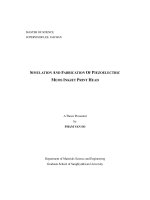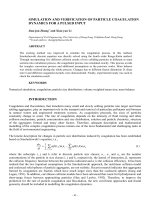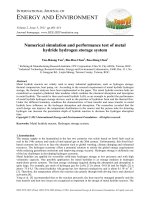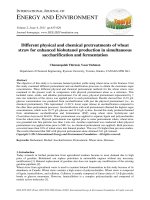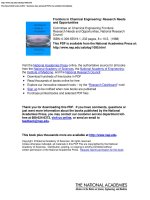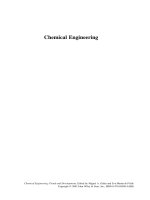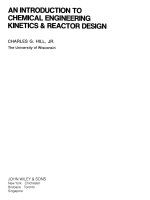dynamic simulation and chemical engineering
Bạn đang xem bản rút gọn của tài liệu. Xem và tải ngay bản đầy đủ của tài liệu tại đây (432.86 KB, 7 trang )
Dynamic
Simulation
and
Chemical
Engineering
Based on the presentation in the 3rd Pan-Hellenic
Chemical Engineering Conference. 31 May - 2 June
2001.
i
DOCUMENT HISTORY
This document is based on the presentation of Kyriakopoulou, D., Poulou, S. and Atha-
nassiou, V. in the 3rd Pan-Hellenic Chemical Engineering Conference. 31 May - 2 June
2001.
For comments on this document please contact Dr. Vassilis Harismiadis
().
OWNERSHIP
This document, the concepts, ideas, designs and commercial offers included therein are
the sole property of Hyperion Systems Engineering Ltd.
Copyright © 2006, Hyperion Systems Engineering, All rights reserved
Dynamic Simulation and Chemical Engineering
1
1 SUMMARY
In dynamic simulation, natural and chemical phenomena are expressed with algebraic and
differential equations based on engineering principles. The mathematical models created
are used for analysing how process behaviour varies with time. For the typical case of a
process industry, we describe/model the plant subunits and their regulatory control. The
relevant equations are solved repeatedly in the time domain and the values of tempera-
ture, pressure, flow and composition as well as the valve openings and the process control
system output are calculated at every point of interest. Thus, the interactions between the
process subunits can become obvious. Further, the process reaction to disturbances (such
as feed variation, instruments failure or change of operation strategy) can be fully investi-
gated.
2 INTRODUCTION
Many of the operations in the Process Industry are naturally dynamic, such as the start-up
and shutdown of a unit, the changeover from one product to another, the operation of
batch reactors or adsorption/regeneration trains etc. Actually, it is practically impossible for
a process unit to operate under strictly constant conditions (steady state). On the other
hand, the industrial process units are becoming increasingly complex with applications of
new technologies that include thermal integration, modern process design and advanced
process control systems. The units are required to operate non-stop for longer periods of
time at optimal conditions. The need for flexibility, regarding processes or equipment, con-
tinuously increases. It is, further, well known that big and fast changes in the plant operat-
ing conditions should be avoided, since the effects of moving from one operational region
to another can be unanticipated and possibly dangerous. Thus, one need to be aware of
the danger zones and when these occur.
In brief, the behaviour of the process unit on the whole is not a simple sum of the plant’s
subunits actions. Safety, environmental, and economic factors highlight the importance of
understanding the design and operating of the plant, as well as the sufficient training of the
plant personnel at a time of an ever-increasing worldwide need for highly qualified and ca-
pable operators. Dynamic simulation is the only economically effective solution to these
needs, since it yields a lot more information than what traditional steady state simulation
offers. This is because dynamic simulation allows us to study a plant’s behaviour in a wide
Dynamic Simulation and Chemical Engineering
2
range of operation conditions, like during start-up or shutdown. Further, it can incorporate
algorithms describing the process unit safety or regulatory control philosophy. Thus, it is
possible to use a dynamic model for the investigation and improved understanding of the
unit's behaviour based on design or operational data.
3 APPLICATIONS OF DYNAMIC SIMULATION
The dynamic simulation applications in the process industry can be used for a variety of
purposes. These include the following.
3.1 Operator Training Systems
In today’s world, where
the developed regions
face massive retirements
of their work force and
where the regions in-
development face a skills
shortage, dynamic proc-
ess models integrated
with the plant’s Distrib-
uted Control Systems
(DCS) can be used to
capture, maintain and de-
velop existing operating
skills. Among others, a
fully deployed operator
training system can be
used to:
• Offer plant operators an improved understanding of the unit operation and handling.
• Familiarize the operators to the process design and the control systems, while empha-
sizing the interactions between the two.
• Demonstrate the use and explain the advantages of advanced process control.
• Control and verify the operators’ actions.
• Practice without the presence of an instructor (stand-alone tool).
3.2 Operation Optimisation
A dynamic model of a process unit can be use to optimise operations. Some typical exam-
ples are:
• Creating, testing and verifying procedures for the safe start-up and shutdown of the
process or for the minimisation of time that plant equipment stays out of operation.
Dynamic Simulation and Chemical Engineering
3
• Finding ways to move the plant operation to equally feasible and safe but more profit-
able conditions.
• Addition of new process lines, before or after start up, for improved plant controllability
during transients.
3.3 Modification of Process and Control System Design
The process design can be relatively easily modified and troubleshot with a dynamic simu-
lator.
• Technical assessment of alter-
native design solutions.
• Dynamic studies: Analysis of
controllability, de-bottlenecking,
depressurising, feed differentia-
tion effects etc.
• Determination of characteristic
equipment parameters (instru-
ment minimum sampling time or
permissible noise levels, control-
ler tuning parameters, control
valves characteristics etc.)
• Compressor performance verifi-
cation and avoiding compressor
surge.
• Effects to plant controllability
due to equipment modifications.
3.4 Investigation of Operational Issues
• Rapid assessment of
alternative solutions to
what-if scenarios.
• Achievement of optimal
plant conditions, after
an unanticipated
change.
• Incident investigation
and procedures for fu-
ture prevention.
• Estimation of functional
parameters for instru-
mentation.
Dynamic Simulation and Chemical Engineering
4
3.5 Safety and Environmental Issues
• Exhaustive testing of plant
procedures and detection of
unfavourable conditions (e.g.
explosive/toxic mixtures, for-
mation and deposition of hy-
drates etc.) due to transients or
malfunctions.
• Verification of depressurising
procedures.
• Verification of DCS and emer-
gency shutdown system con-
trol loops and sequences.
4 REFERENCES
[1] Nisenfeld A. E., 1982. Principles of Operation and Control, ISA, Monograph Series 3.
[2] AspenTech Modelling Philosophy, 1998. AspenTech Ltd.
[3] Gas Injection Plant, 1997. SAST Ltd.
CYPRUS
Hyperion Systems Engineering Ltd.
Nimeli Court, 1st Floor, 41-43 Agiou Nicolaou Street,
CY-2408 Nicosia, Cyprus
Tel: +357.22.840700, Fax: +357.22.590009
UK
Broner Metals Solutions Ltd
1, Century Court, Tolpits Lane, Watford, WD18 9PT, UK
Tel: +44.1923.65200, Fax: +44.1923.816456
e-mail:
web site: HTUwww.bronermetals.comUTH
GREECE
Hyperion Systems Engineering SA
10 – 12 Doryleou Street GR-11521 Athens, Greece
Tel: +30.210.8704900, Fax: +30.210.6433368
RUSSIA
OOO Hyperion Systems Engineering (RUS)
7, Korovy Val Street, Entrance 1, Office 9, 117049 Moscow, Russia
Telephone: +7095.5040477 Fax: +7095.5040478
BAHRAIN
Hyperion Systems Engineering Co. W.L.L.
Diplomat Tower, Building 315, 9th Floor, Office No 905, Road 1705, Block 317,
Manama, Diplomatic Area, Kingdom of Bahrain
Tel: +973.17.531270, Fax: +973.17.531271
INDIA
Hyperion Systems Engineering (India) Private Limited
Gandhi Empire, Plot No 2, S. No 595/1, 5th Floor, Sareen Estate
Kondawa Rd, Mouji Munjeri, Bibewadi, Pune-411040, India
Tel: +91.20. 39845800, Fax: +91.20. 39845900
e-mail:
Web site: HTUwww.hyperion.com.cyUTH
